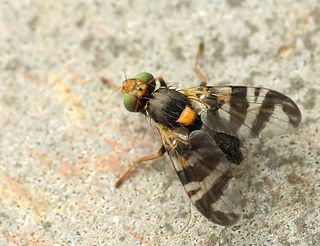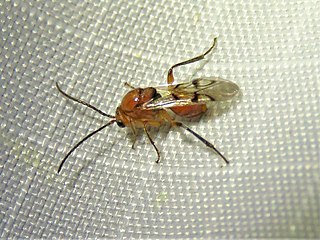
A railroad worm is a larva or larviform female adult of a beetle of the genus Phrixothrix in the family Phengodidae, characterized by the possession of two different colors of bioluminescence. It has the appearance of a caterpillar. The eleven pairs of luminescent organs on their second thoracic segment through their ninth abdominal segment can glow yellowish-green, while the pair on their head can glow red; this is due to different luciferases in their bodies, as the reaction substrate, called luciferin, is the same.

The Tachinidae are a large and variable family of true flies within the insect order Diptera, with more than 8,200 known species and many more to be discovered. Over 1,300 species have been described in North America alone. Insects in this family commonly are called tachinid flies or simply tachinids. As far as is known, they all are protelean parasitoids, or occasionally parasites, of arthropods, usually other insects. The family is known from many habitats in all zoogeographical regions and is especially diverse in South America.

The Ichneumonidae, also known as ichneumon wasps, ichneumonid wasps, ichneumonids, or Darwin wasps, are a family of parasitoid wasps of the insect order Hymenoptera. They are one of the most diverse groups within the Hymenoptera with roughly 25,000 species described as of 2016. However, this likely represents less than a quarter of their true richness as reliable estimates are lacking, along with much of the most basic knowledge about their ecology, distribution, and evolution. It is estimated that there are more species in this family than there are species of birds and mammals combined. Ichneumonid wasps, with very few exceptions, attack the immature stages of holometabolous insects and spiders, eventually killing their hosts. They thus fulfill an important role as regulators of insect populations, both in natural and semi-natural systems, making them promising agents for biological control.

In evolutionary biology, sympatric speciation is the evolution of a new species from a surviving ancestral species while both continue to inhabit the same geographic region. In evolutionary biology and biogeography, sympatric and sympatry are terms referring to organisms whose ranges overlap so that they occur together at least in some places. If these organisms are closely related, such a distribution may be the result of sympatric speciation. Etymologically, sympatry is derived from Greek συν (sun-) 'together', and πατρίς (patrís) 'homeland'. The term was coined by Edward Bagnall Poulton in 1904, who explains the derivation.

The apple maggot, also known as the railroad worm, is a species of fruit fly, and a pest of several types of fruits, especially apples. This species evolved about 150 years ago through a sympatric shift from the native host hawthorn to the domesticated apple species Malus domestica in the northeastern United States. This fly is believed to have been accidentally spread to the western United States from the endemic eastern United States region through contaminated apples at multiple points throughout the 20th century. The apple maggot uses Batesian mimicry as a method of defense, with coloration resembling that of the forelegs and pedipalps of a jumping spider.

Ammonium carbonate is a salt with the chemical formula (NH4)2CO3. Since it readily degrades to gaseous ammonia and carbon dioxide upon heating, it is used as a leavening agent and also as smelling salt. It is also known as baker's ammonia and is a predecessor to the more modern leavening agents baking soda and baking powder. It is a component of what was formerly known as sal volatile and salt of hartshorn, and produces a pungent smell when baked. It comes in the form of a white powder or block, with a molar mass of 96.09 g/mol and a density of 1.50 g/cm3. It is a strong electrolyte

Trichogramma is a genus of minute polyphagous wasps that are endoparasitoids of insect eggs. Trichogramma is one of around 80 genera from the family Trichogrammatidae, with over 200 species worldwide.

The codling moth is a member of the Lepidopteran family Tortricidae. They are major pests to agricultural crops, mainly fruits such as apples and pears, and a codling moth larva is often called an "apple worm". Because the larvae are not able to feed on leaves, they are highly dependent on fruits as a food source and thus have a significant impact on crops. The caterpillars bore into fruit and stop it from growing, which leads to premature ripening. Various means of control, including chemical, biological, and preventive, have been implemented. This moth has a widespread distribution, being found on six continents. Adaptive behavior such as diapause and multiple generations per breeding season have allowed this moth to persist even during years of bad climatic conditions.
Diachasma alloeum is a small wasp in the family Braconidae. It is a parasitoid of Rhagoletis pomonella, the apple maggot. The wasp lays its eggs into third-instar larvae of the fly, which then develop after the larvae have pupated. The immature wasps then eat the fly larvae and overwinter inside the fly puparia.

Parasitoid wasps are a large group of hymenopteran superfamilies, with all but the wood wasps (Orussoidea) being in the wasp-waisted Apocrita. As parasitoids, they lay their eggs on or in the bodies of other arthropods, sooner or later causing the death of these hosts. Different species specialise in hosts from different insect orders, most often Lepidoptera, though some select beetles, flies, or bugs; the spider wasps (Pompilidae) exclusively attack spiders. More rarely, parasitoid wasps may use plant seeds as hosts, such as Torymus druparum.

Trigonalidae is one of the more unusual families of hymenopteran insects, of indeterminate affinity within the suborder Apocrita, and presently placed in a unique superfamily, Trigonaloidea, and the only extant taxon in the superfamily. The other putative related taxon is the extinct family Maimetshidae, known from the Cretaceous period. Trigonalidae are divided into 2 subfamilies; Orthogonalinae and Trigonalinae. These wasps are extremely rare, but surprisingly diverse, with over 90 species in 16 genera, and are known from all parts of the world. It is possibly the sister group to all Aculeata.

Rhagoletis is a genus of tephritid fruit flies with about 70 species.

Rhagoletis mendax is a species of tephritid fruit fly known by the common name blueberry maggot. The blueberry maggot is closely related to the apple maggot, a larger fruit fly in the same genus. It is a major pest of plant species in the Ericaceae family, such as blueberry, cranberry, and huckleberry. The larva is 5 to 8 mm long, apodous, and white with chewing mouthparts. Female adults are 4.75mm in length, males are slightly smaller. Both adults are mostly black in color with white stripes, orange-red eyes, and a single pair of clear wings with black banding. The adult female fly lays a single egg per blueberry, and when the larva hatches it consumes the fruit, usually finishing the entire berry in under 3 weeks and rendering it unmarketable. The larva then falls to the soil and pupates. Adult flies emerge, mate, and females oviposit when blueberry plants are producing fruit. Each female fly can lay 25 to 100 eggs in their lifetime.
Rhagoletis juglandis, also known as the walnut husk fly, is a species of tephritid or fruit fly in the family Tephritidae. It is closely related to the walnut husk maggot Rhagoletis suavis. This species of fly belongs to the R. suavis group, which has a natural history consistent with allopatric speciation. The flies belonging to this group are morphologically distinguishable.

Rhagoletis zephyria is a species of tephritid or fruit fly in the genus Rhagoletis of the family Tephritidae. Visually similar to Rhagoletis pomonella and often misidentified as such.

Trissolcus japonicus, the samurai wasp, is a parasitoid wasp species in the family Scelionidae, native to east Asia but now found in Europe, North America, and Chile. It is chiefly known for parasitizing Halyomorpha halys. It deposits eggs into the eggs of the stink bug, and as the wasp larvae develop, they kill the stink bug eggs. A single adult wasp emerges from each stink bug egg.
The bacterial species "Pseudomonas melophthora", can be found in the apple maggot, Rhagoletis pomonella. This can be considered a form of symbiosis as, amongst other things, the bacteria has the ability to degrade insecticides and so offers a form of protection to the apple maggot.

The Apple Maggot Quarantine Area is a permanent quarantine area established by the U.S. state of Washington. The quarantine was authorized under Washington state law and the area's boundaries are periodically reset by the state's Department of Agriculture. The quarantine was declared in the early 1980s to arrest the spread of the apple maggot into a portion of Eastern Washington.

Belonocnema is a genus of oak gall wasps in the family Cynipidae. There are three described species: B. treatae, B. fossoria and B. kinseyi. These species are found in the United States from Texas, east to Florida.
Ronald John Prokopy was an American entomologist who was a specialist on the behavior and biology of Rhagoletis flies and approaches to their management in apple orchards.















